The ultimate guide to sensory diets that includes a sensory diet template PDF, powerful sensory diet examples, and 4 steps to make your own sensory diet today!
Affiliate links used below. See our full disclosure.
Are you hearing about a sensory diet for the first time? Wondering how to create a sensory diet for your child?
While it may seem complicated, as an occupational therapist I’m here to break it all down into something that you understand, one step at a time.
Consider this PDF template and article your ultimate guide to:
- What is a sensory diet?
- The types of sensory issues a sensory diet helps
- How to create a sensory diet for your own kid with our template!
- Powerful real-life sensory diet examples
While you may be tempted to scroll past all the details and head right to the printable, I encourage you to read through the 4 simple steps and sensory diet examples for how to incorporate a sensory diet into your kid’s everyday routine.
What is a Sensory Diet?
The term sensory diet can sound overwhelming and time consuming, but it doesn’t have to be.
A sensory diet is a way of providing or decreasing sensory input through specific activities and supports to help a child stay regulated throughout the day.
These activities and supports are chosen based on the child’s unique sensory processing needs, and ultimately help a child calm down and focus so they can participate in age appropriate activities.
If a child is dysregulated, meaning their sensory system is disorganized, then kids may struggle to complete activities that are expected of them like learning, playing, socializing, getting dressed, brushing teeth, etc.
Types of Sensory Issues for a Sensory Diet
There are a variety of sensory issues, or needs, that kids cause dysregulation.
Some kids have a high threshold for sensory input, so they look for opportunities to experience sensations such as running, jumping, crashing, smelling, licking, etc. These kids are often referred to as sensory seekers.
For others, they have a low threshold, and their environment is constantly giving them too many sensations. They become overstimulated, and thus dysregulated from textures of clothing, smells, lights, movement, etc.
These kids have sensory sensitivities and are often called avoiders.
And, some kids don’t seem to register much of any sensory input, as a result they are lethargic and unfocused. These kids have what’s called low registration.
Sensory issues can be sneaky, check out 10 easy to miss sensory red flags that could benefit from a sensory diet.
A Sensory Diet May Change from Day to Day
The tricky part is that kids can fluctuate among states of calm, seeking or avoidance depending on factors like the environment they are in, how well they slept, or what kind of day they’re having.
For this reason, it’s important that a sensory diet is fluid and adaptable to the changing preferences and needs of your child on a day to day basis.
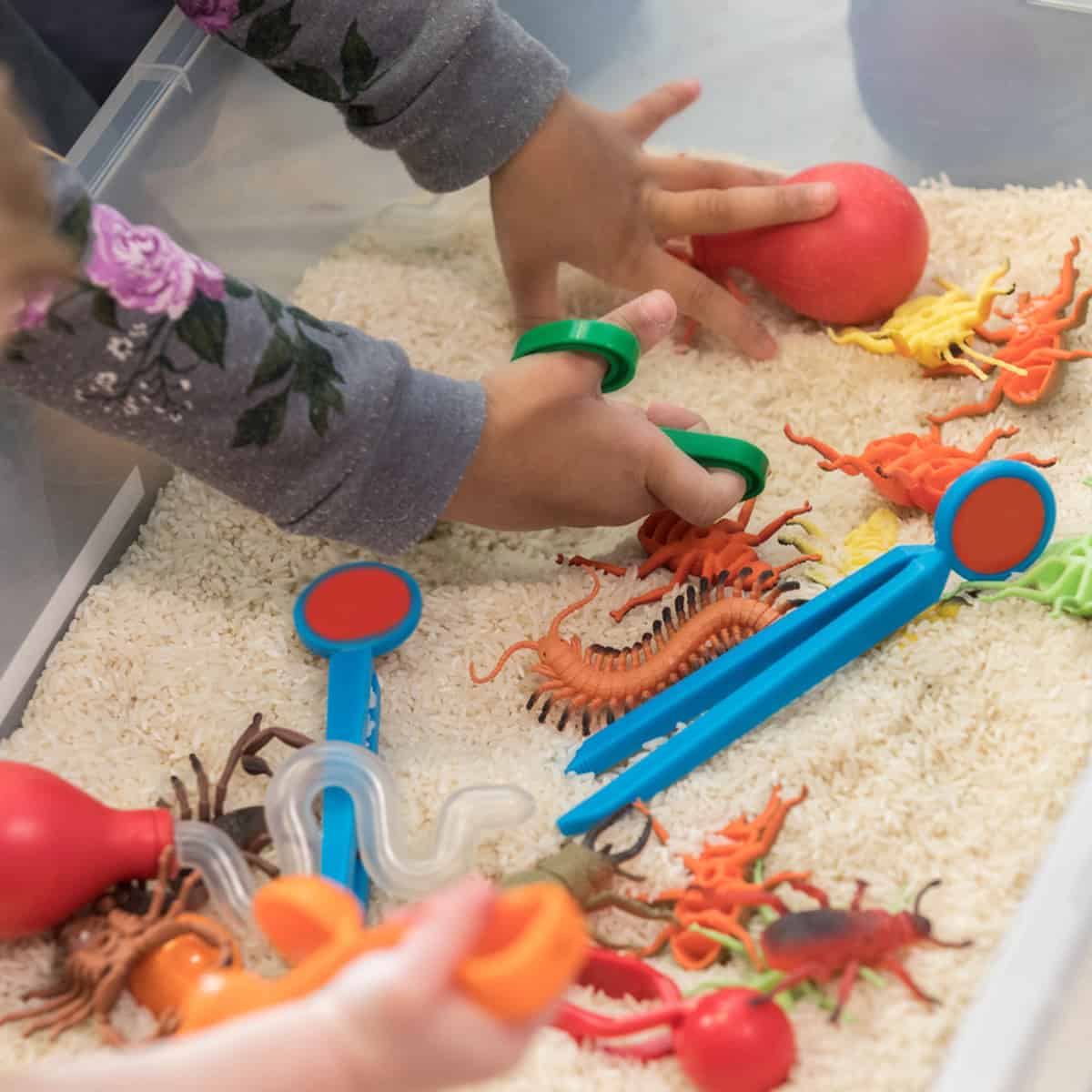
While sensory diets are specific to each child, they all have the same goals: to regulate the sensory system, prevent meltdowns, improve focus and attention, and/or to increase your child’s tolerance to the sensations they experience in their environment.
Who Needs a Sensory Diet?
If you’re reading this, you likely have a child who is showing signs of sensory processing issues. Sensory issues can be mild or severe, and because of that you can expect 3 different categories of kids to benefit from a sensory diet:
1. Children with sensory issues but no diagnosis.
Oftentimes these children show behaviors that aren’t “significant” enough to put a label or diagnosis on them, and many will dismiss them for personality traits.
Sometimes people call these kids: hyperactive, wild, highly sensitive, intense or strong-willed. When I hear these descriptions, I can usually bet that sensory processing is at least partially to blame and using a sensory diet can diminish or even eliminate these challenging behaviors.
2. Children with Sensory Processing Disorder (SPD)
While most, if not all kids, can benefit from sensory activities, if your child does have a SPD diagnosis then a sensory diet is a tremendously helpful tool because they’re sensory needs are impacting their life in significant ways.
Check out these 33 signs of Sensory Processing Disorder to see if your kid might fall into this category.
3. Children with Autism and ADHD
Kids with ASD and ADHD often have sensory issues that often lead to dysregulation. If unchecked this sensory dysregulation can result in a meltdown. Since most kids with Autism and as many as 40% of kids with ADHD have known sensory needs, a sensory diet can be an invaluable tool to improve attention, sleep, socialization, and even eating.
How to Create a Sensory Diet with the PDF Template
One of the biggest mistakes I see parents make with a sensory diet is that they randomly use any sensory activity during the day without knowing why.
While this PDF sensory diet template is made for you to use as a tool, it will still require a bit of brainstorming to determine what exactly your child needs to help them regulate..
I have 4 quick steps for you to work through so that when you print out your sensory diet template you are confident with how (and, why) you’re filling it out.
In the next section, I share some sensory diet examples so you can see exactly how I work through these steps in my home (yes, I have a sensory kid) and when I’m helping other parents.
Sensory Diet Step #1: Write down when your is having a hard time
Make a list of the times of day or the environments that your child experiences challenges or seems to be seeking sensory input.
Don’t overthink this, just grab a piece of paper and start writing out the times your child is tantruming, having difficulty, overwhelming you, or is confusing you with their actions.
Sometimes sensory kids have unusual behaviors to get their sensory needs met (like crossing their fingers for seemingly no reason, pulling their hair, or biting their toenails). Write down anything that comes to mind!
Sensory Diet Step #2: Link challenges to sensory issues
Look at your list and check off anything that is caused by their sensory needs or you feel could be helped by sensory activities.
Aren’t sure? Here are some examples of common sensory issues. But, please note, this is not a complete list, there are sooo many sensory needs and behaviors:
- Difficulty waking up or getting out of bed in the morning
- Particular about the type of clothing they wear
- Anxious before school or doing a different activity
- Won’t sit still at the table during meals
- Tantrums when it’s time to run an errand
- Flips out in the store for seemingly no reason or because of the lights, sounds, and environment in general
- Very rough in their play with siblings, parents, and other children*
- Overly shy and awkward in public or on play dates
- Refuses to leave the house
- Climbs furniture unsafely*
- Obsessed with swinging and/or spinning*
- Hates getting messy
- Touches everything and gets overly messy, seeming not notice*
- Licks everything*
- Gags at new or different foods on their plate or even on the table for meals
- Stares at spinning objects like a ceiling fan
- Difficulty paying attention in school or during structured activities
- Completely can’t stand bright lights
- Loses it with loud noises
- Fearful of climbing playground equipment, the stairs, or getting on a swing
- Refuses to have teeth brushed
- Can’t seem to settle down to go to sleep
- Bites people of objects for seemingly no reason or when they are excited or upset*
- Has a hard time sleeping through the night
- Chews on toys, pencil tops, and other objects frequently*
- Smells everything*
*Indicates your child is seeking, or looking for, more sensory input. See more sensory red flags.
Sensory Diet Step #3: Use sensory activities or supports
Choose sensory diet activities to try and offer before you know your child’s typical struggles (i.e.: before bed, transitioning between activities, etc.) Or, you can use the sensory activities and supports as needs pop up. You definitely won’t be able to predict them all.
It may even be several trial and error attempts before locking a plan into place.
But I promise it will be worth it!
The most important thing is that you offer an activity as part of your routine because you know it’s a challenging area for your child OR you give an activity/support when you see they need it.
In either instance, you really want to try and think about what your child’s “need” is and then match an activity that might help. It isn’t totally random. We will get into some examples in just a minute.
To help you narrow down what activities your child might benefit from, I have a few shortcuts:
- 100+ Sensory Diet Activities – The best overall list because it’s filled with and is organized by activities that are calming and those that help your child focus.
- Oral Sensory Processing Activities – Both for kids that love chewing, licking, mouthing everything, or ones that refuse to do any of those things.
- Powerful Proprioceptive Activities
- Vestibular Activities
- Sensory Seeking Activities – Perfect for “wild” or rough kids
- How to Create a Sensory Tent – A great sensory diet activity that is incredibly helpful for kids to retreat to when they’re overstimulated
- Sensory Diet Activities for the Classroom
- Tactile Activities
- Messy Play Ideas
- How to Help Your Child Stay Seated at the Table
- Sensory Tricks for Sleeping
Some kids benefit from using sensory diet cards, which are a visual image or graphic of various sensory diet activities. To make your child a proactive participant in their sensory diet you can offer them 2-3 sensory diet cards and let them choose which activity would be helpful. You can also use a visual schedule.
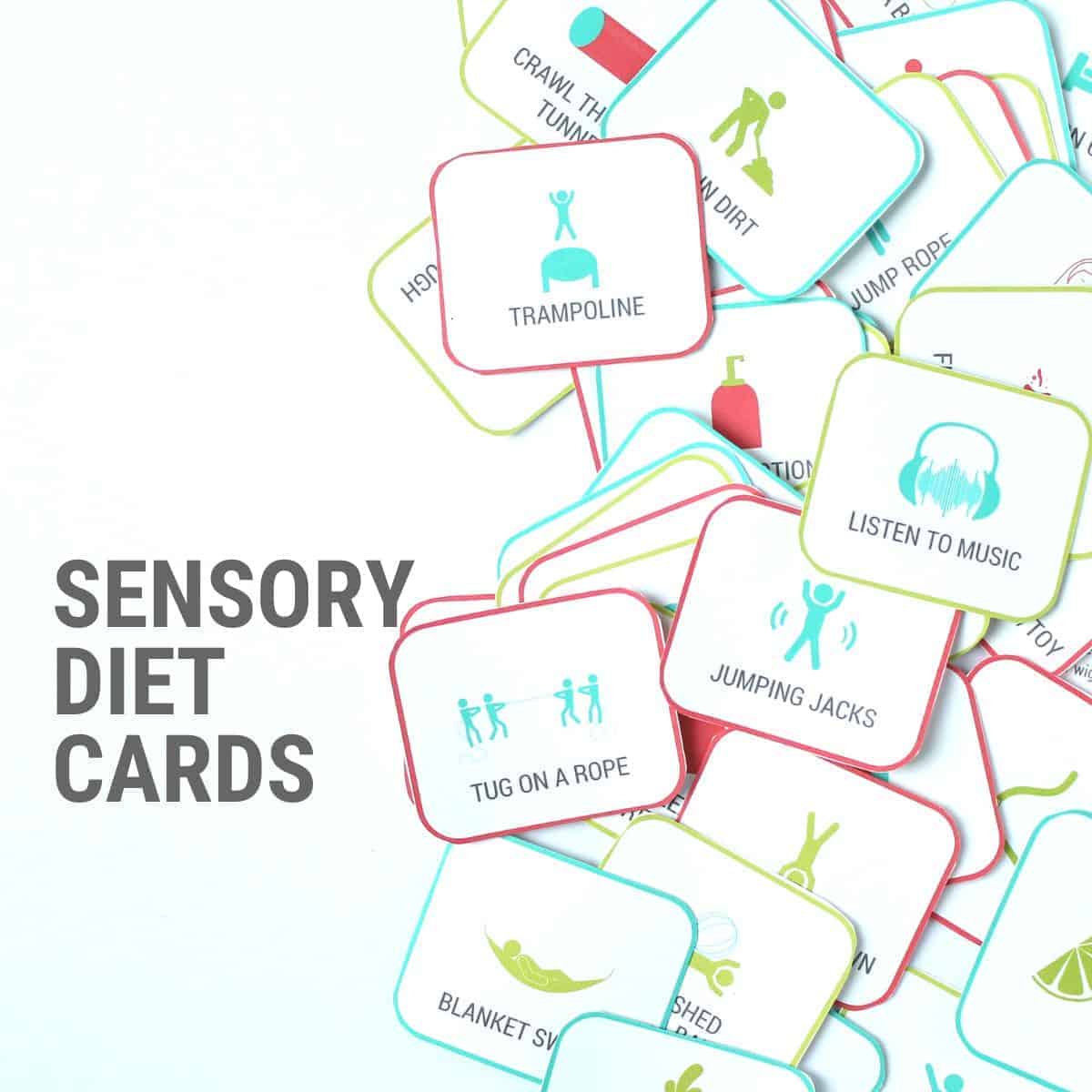
Learn more about using sensory diet cards and check out my set of 60 my favorite (and most powerful) sensory diet activities.
Sensory Diet Step #4: Evaluate
This last step is to observe how your child responds to the sensory activities that you offer.
Remember that the whole point of a sensory diet is to improve their focus, calm them, or meet their needs.
If the activity wasn’t what they needed or didn’t “work” for any number of reasons, it doesn’t mean it was a failure. That same activity may work tomorrow. Offer it or suggest it at least 3-4 times before you abandon it.
But, NEVER force any sensory diet activity.
While it’s important to be open to offering activities again, you also want to look for what your child likes and is gravitating towards.
If you notice that jumping down the stairs in the morning helps them sit better for breakfast, that’s awesome, you just created a sensory diet. Definitely try that again.
Some kids will want to repeat the same thing everyday and others may not even need it day in and day out. Or, they want to have a variety of activities they can cycle between.
When you use the template, think of it as a sensory diet worksheet that might be ever-changing and flexible!
Awesome Sensory Diet Examples
Now that you understand what a sensory diet is, who it is for, and how to make one, it’s finally time to see some of that in action.
While I can’t possibly cover every possible situation, use these sensory diet examples to inspire how you create your child’s sensory diet using the template. A lot of these examples are from my own home or from kids that I’ve worked with:
- A little girl has a hard time going upstairs for bed and often tantrums. Besides giving her reminders about the approaching bedtime, her family gives her a piggyback ride upstairs, jumping and stomping all the way. She’s calmer because she got vestibular, proprioceptive, and tactile input.
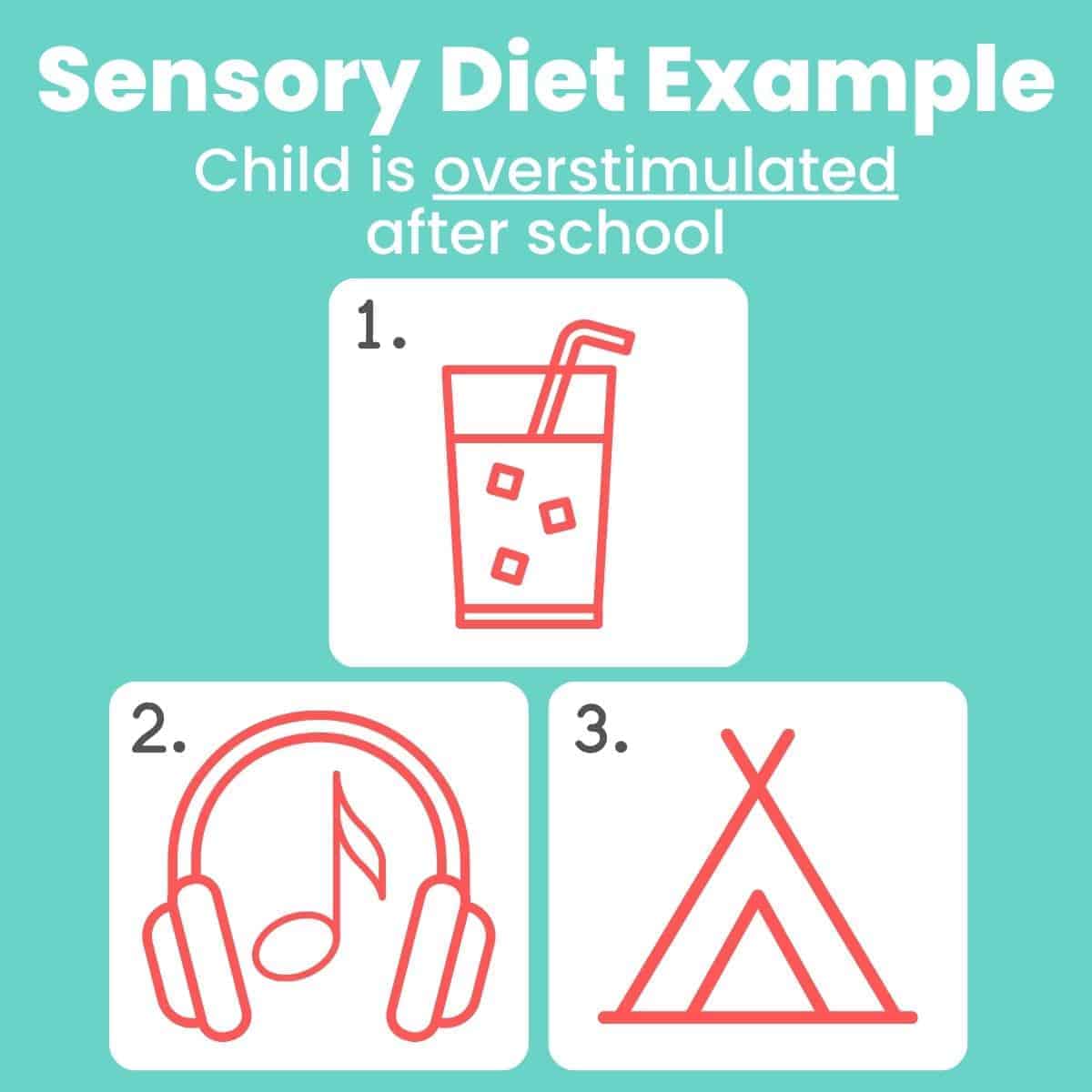
- A boy comes home from school and is overstimulated and irritable. His mom gives him a cold drink through a straw, puts on relaxing music, and gives him some time in his sensory tent before starting homework.
Check out more examples of an after school routine.
- When my son was younger, he was very sensitive to different textures and only ate a small variety of foods. To help him get more comfortable with different textures, he played in different sensory bins a couple times a week, which decreased his sensitivity to texture and helped him eat new foods.
- A toddler can’t stand getting his toenails cut so his mom gives him time on a swing first, because he loves that and it helps calm him. Then she holds him tightly in her lap while he holds a weighted lap pillow for comfort and deep pressure input.
- A school aged girl struggles to sit still in school and focus throughout the day. Her dad makes sure she has 5 minutes to jump on a small trampoline in the house before she leaves. Then she rides her bike to the bus stop and has a stretchy band around her chair at school that she can kick when she feels like she needs to move and can’t.
- A boy is really nervous going to daycare every day. To help him, he carries a stress ball in his pocket that he can squeeze whenever he needs to. He also has crunchy foods in his lunch, which help him stay calm, as well.
- My son is a sensory seeker and loves to play rough. Throughout our normal daily interactions, I make an effort to give him big deep hugs if he walks by I rough house with him for a minute or two. It isn’t scheduled into our day at any specific time.
- A girl that is really active and loves to swing has access to a scooter board and rocking toy whenever she needs it. She doesn’t use it everyday, but she knows where to find it and how to use it when she does feel the need.
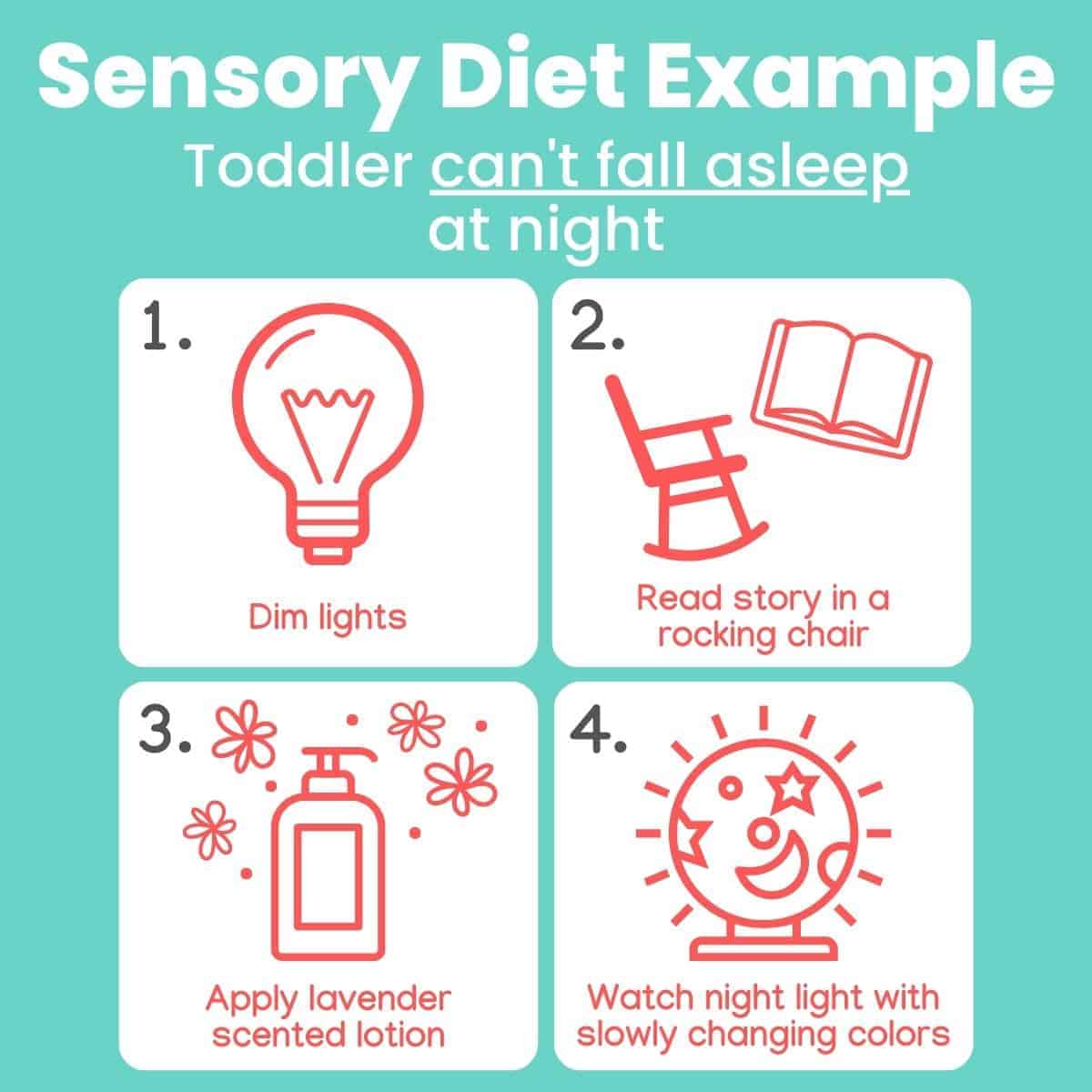
- A toddler can’t seem to fall asleep every night. To help prepare him for sleep, the parents keep lights dim, read stories while snuggling in a rocking chair, and give a massage with lavender scented lotion. He falls asleep watching a slow changing night light. (We have one like this, it’s one of my favorites.)
- A child hates the bright light and noises in large stores. His family keeps a bag in the car with some headphones, sunglasses, and some small toys he can fidget with in the store.
- A boy won’t climb or swing on anything at the playground. Once or twice a week his mom sets up some obstacles with couch pillows for him to crawl over in the house. They also take toys to the playground and play on the steps that go up to the low slide, slowly getting closer to the top over time.
Are you starting to see how you can use a sensory diet to help your child through these examples? If you have any questions about your situation, ask us in the comments!
The Sensory Diet Template: Free Printable PDF
Here it is, the final piece to creating a sensory diet for your child. This worksheet, which includes sensory diet activities is a visual tool to help you put what you just learned into action!
Click here and we’ll send this printable right to your email so you have it download, save, or print.
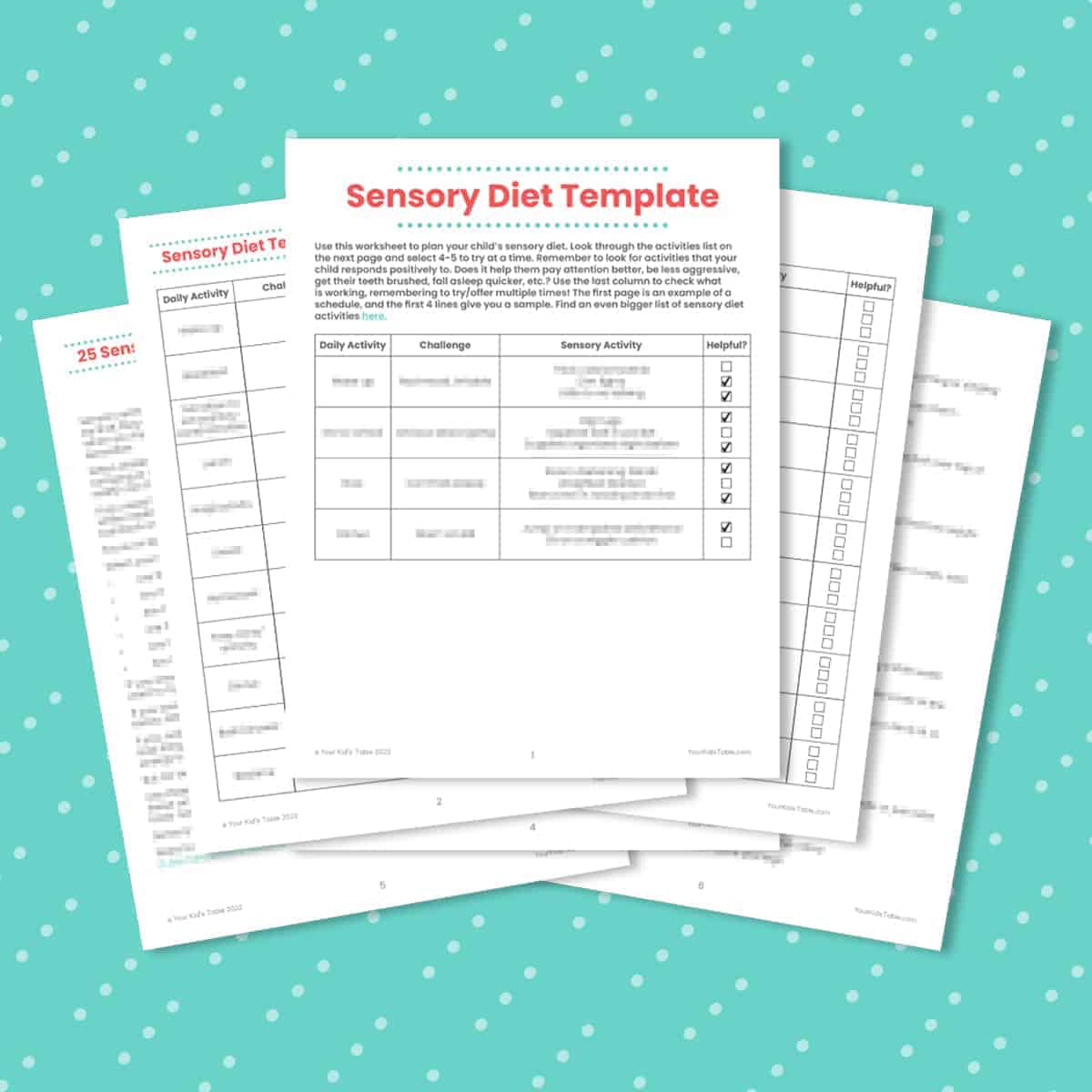
Take creating and fine tuning your child’s sensory diet it one step at a time..
Once you have several options you know they like, you can even offer choices to them when you know they need a sensory diet activity.
I’ll say to my son, “Hey, it’s not safe to run around the house right now. Would you like to jump on the trampoline or ride the scooter board in the hallway?”
Kids love choices and they usually know how to meet their sensory needs better than we do when we give them the chance.
What challenge is your child facing? What activities are you going to use to help them, as you create your own sensory diet? Tell me in the comments, and we can all learn from each other.
Hearing other people’s examples is one of the most powerful ways we can learn!
Get the Sensory Diet Template Pack here!
More Sensory Ideas and Tips
How to Choose the Right Sensory Toy for Your Child
How to Support Sensory and Discipline Fairly
Sensory Processing and Picky Eating
10 Awesome and Affordable Sensory Toys
Did You Pin This?
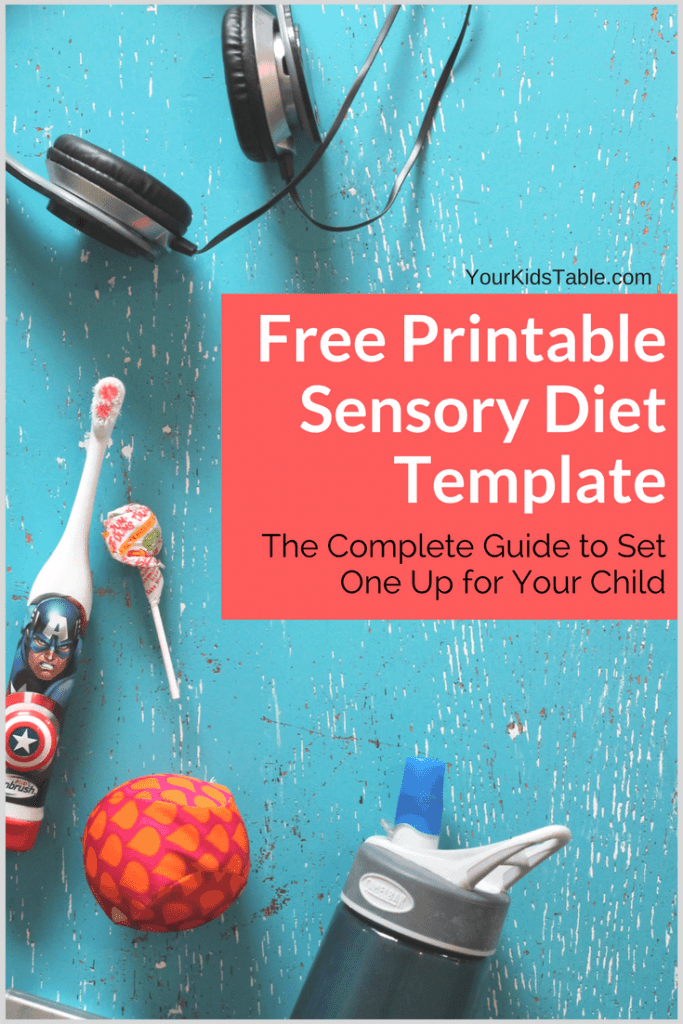
Alisha Grogan is a licensed occupational therapist and founder of Your Kid’s Table. She has over 19 years experience with expertise in sensory processing and feeding development in babies, toddlers, and children. Alisha also has 3 boys of her own at home. Learn more about her here.
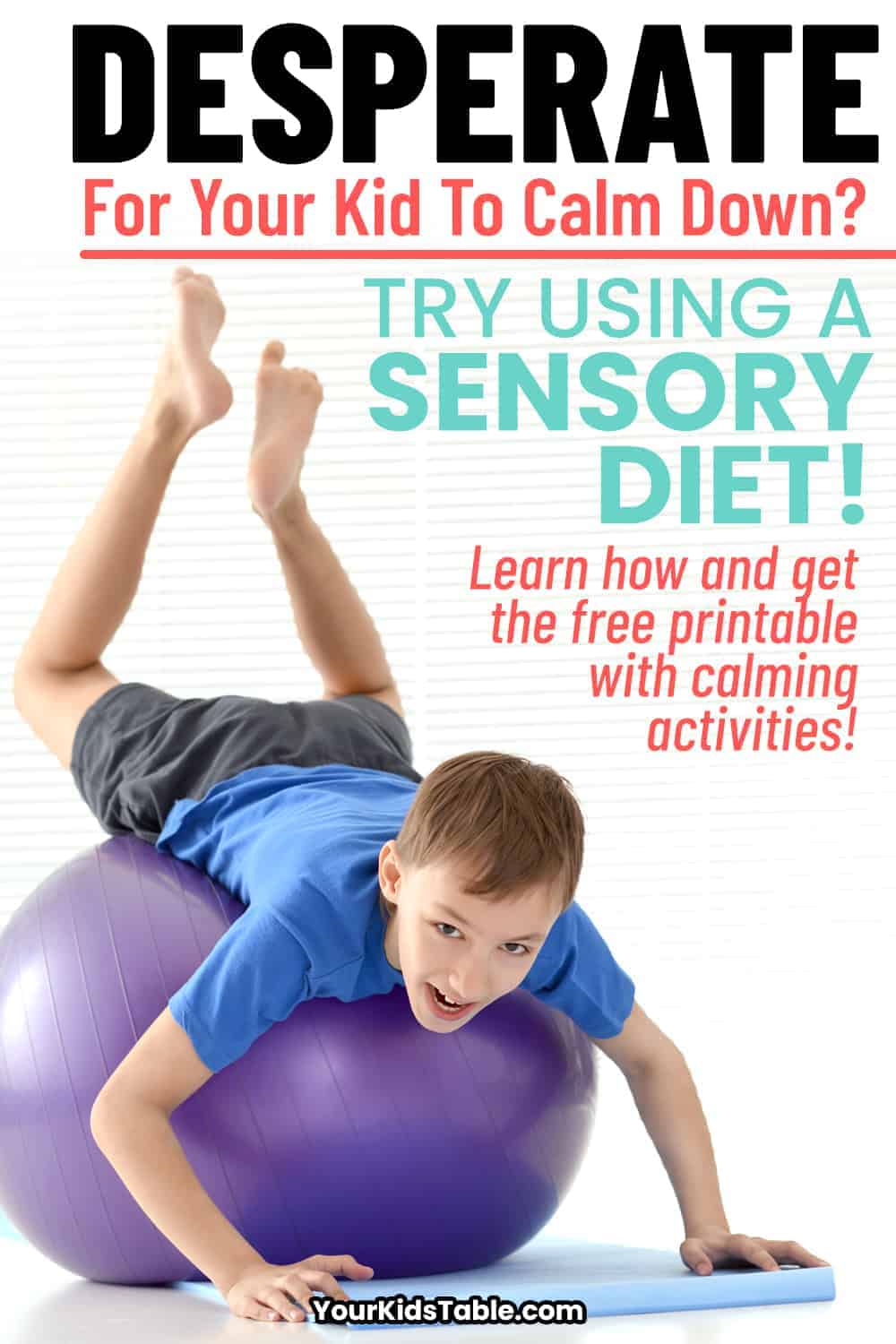
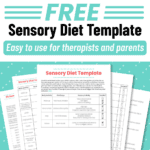
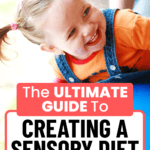
I didn’t receive the template. Can you resend it to me please?
Just re-sent to your email listed here! Be sure to check your spam/promotions!
Best,
Laura
Your Kid’s Table OT
Hi there! I didn’t receive this packet in my email either- May I please get this sent again? Thank you!
Hi Caitlin,
I just re-sent to the email you have listed here. Make sure to check spam and promotions!
Best,
Laura
Your Kid’s Table team member
Hi there! i subscribed but have not received anything! Please could you email me this?
Just sent!
Best,
Laura
Your Kid’s Table OT
Hi Alisha. The Sensory Diet Template response email is not working. I checked my spam/clutter/promo folders-not there either.
Hi Karen,
Sending again to the email you have listed here! Let me know if you still don’t see it!
Best,
Laura
Your Kid’s Table OT
Hi, I did not receive the template either. Could you please try to send it. Thank you!
Tannia,
You should see it come through to the email you have listed here. If you still don’t, please email hello@yourkidstable.com. This printable has been updated to include this template plus more sensory resources so I hope you enjoy!
Best,
Laura
Your Kid’s Table team member
Hello there I did not receive any of the sensory templates. I have checked junk mail and there are not there either. Love your website!
Hi Serena,
I just had it sent to the email you have listed here. This sensory diet has been updated and expanded to a printable with even more sensory resources. If for some reason you still don’t see it, email hello@yourkidstable.com and we will get you squared away!
Best,
Laura
Your Kid’s Table team member
I did not receive the template and the other email for A sample sensory diet, Shareable sensory diet template, anf 25 awesome sensory diet activities (some of my favorites!) Csn you resend them?
Just resent! Let me know if you still don’t see!
Best,
Laura
Your Kid’s Table team member
Ive checked every email category I have and Ive not received the templates.
Hi there,
I manually entered you with the email listed. If you still do not see, please email hello@yourkidstable.com for assistance.
Best,
Laura
Your Kid’s Table team member
i have not recieved the download i have checked spam, promotions, junk, and inbox
Hi there,
I manually entered you with this email. If you do not see it still, email hello@yourkidstable.com.
Best,
Laura
Your Kid’s Table team member
hi i have checked all inboxes and did not receive the template.
Hi Jen,
I just sent again to the email you have listed here! Let me know if you don’t see it.
Best,
Laura
Your Kid’s Table team member
Hi Alisha! The Sensory Diet Template response email is not working here either. I checked my spam folder-not there either. BTW, I am really excited regarding my purchase of the sensory diet cards!
Hi Leela,
I sent to the email listed here. Make sure you check your spam and promotions folders in case they get sorted there. So glad you’re getting the sensory diet cards too!
Best,
Laura
Your Kid’s Table team member
The link to get the sensory diet template is not working for me.
Hi,
I sent to the email listed here. Make sure you check your spam and promotions folders in case they get sorted there.
Best,
Laura
Your Kid’s Table team member
Hi! I also did not receive the template
Hi April,
I sent to the email listed here. Make sure you check your spam and promotions folders in case they get sorted there.
Best,
Laura
Your Kid’s Table team member
I am not receiving download of sensory templates
I just re-sent to the email you have listed here. Make sure to check spam/promotions!
Best,
Laura
Your Kid’s Table team member
Hi
Can i get a copy plesse
Hello, can you please send me the sensory diet template. I think the link to request it does not work. *
I just sent it to the email you have listed here. Enjoy!
Best,
Laura
Your Kid’s Table team member
The link is still not working. Please email me the Sensory Diet Template. Thank you
Hey Marissa, as per the email I just sent you, it’s not a direct download and you do need to sign up. I have signed you up and everything was sent to you!
Best,
Desiree
Can I get sent a copy of the download as the link is not working
Hi Grace,
I just sent to the email you have listed here.
Best,
Laura
Your Kid’s Table team member
Hi
Please could you send me the template the download hasn’t worked,
Many thanks
Hey Georgia,
I looked into your account and it was sent! I would try searching in your email for “hello@yourkidstable.com” or “Alisha” to see if you can locate the email. These can get trapped into spam!
Best,
Desiree
Your Kids Table Team Member
Hi Georgia,
I just sent to the email you have listed here.
Best,
Laura
Your Kid’s Table team member
I would like the download for the sensory diet template however the emails are not coming through when I click the link. Are you able to send it?
Hi Ellen,
I just sent again. Let me know if you don’t see it!
Best,
Laura
Your Kid’s Table team member
Hello,
I also am not getting the template via email. Can you it send to me?
Thanks!
Hey Emily,
You do need to sign up! It’s not a direct download. When you click on the link, there will be a box to put your name and email to receive it! I looked into your account and you are not signed up to receive it. I’ve signed you up just now, so you should see it in a few minutes. If you still can’t locate search your email for “hello@yourkidstable.com” or “Alisha” to try to pull it up!
Best,
Desiree
Hi Emily,
I just sent it to your email. Let me know if you still don’t see it. Make sure to check your spam and promotions folder in case it got sent there accidentally.
Best,
Laura
Your Kid’s Table team member
Links still do not work
I am Occupational Therapist I need PDF free sensory Diet
Hi Mureed,
I just sent to you. Make sure to check spam and promotions.
Best,
Laura
Your Kid’s Table team member
Would love this download. Form doesn’t appear to work…
Can I have the template please?
Hi Carly, I just sent to your email listed here.
Best,
Laura
Your Kid’s Table team member
Hi Bridget,
I just sent to your email listed here. Let me know if you don’t see it.
Best,
Laura
Your Kid’s Table team member
Hi! The form also will not send to me. Can you please send it?
hi thanks for sharing this post very useful.
I have two medical rehabilitation center in Tehran, in this center we work on sensory processing disorder. this post help us.
Hi there,
We are so happy you found this resource helpful, and are thrilled to see it impacting people around the world.
Best,
Laura
Your Kid’s Table team member
Hi! Can you also send me a copy of the daily sensory template. I appreciate your insight on this and I am excited to see how it can help my child. THANKS!
Hi! I attempted to get the template sent to my email, however it does not appear to be going through. I have checked all folders. Could you send me a copy? Thank you!
Hey Brittany,
Thanks so much for reaching out! We’ve signed you up for the printable, you should see it come through shortly!
Best,
Desiree
I to have waited some time for a printable I signed up for. I tried last night and yet to receive anything.
Kiara,
I sent to your email listed here. Let me know if you continue to not see, making sure you check your spam and promotions.
Best,
Laura
Your Kid’s Table team member
Hi! Can you please send me a sensory diet template ?
Hi Raquel! It was sent to your email! Be sure to also check your spam folder. Let us know if you dont receive it within 24 hrs 🙂
Best,
Kalyn
Hi, I signed up but didnt receive an email 🙁
Hi Lorna,
I just sent to the email you have listed here. Make sure you check spam/promotions in case it got sent there.
Best,
Laura
Your Kid’s Table team member
Hello ! Do you have tips for helping work with a kid on getting used to wearing headphones? I have several that could benefit but understandably, they don’t like wearing them (yet). Any tips are appreciated. Thanks!
hi there….can you please send me you sensory diet worksheet and template?
thank you very much….
Hi Maria! It was sent to your email— be sure to also check your spam folder!
Best,
Kalyn
Hi can you send me on too
Hi Valerie, I just sent the template to the email listed here. If you don’t see it, make sure to check your promotions or spam folder.
Best,
Laura, Your Kid’s Table team member
Hi, please could I have a copy of the sensory diet template? Thank you!
Hi Izabella,
I just sent this to the email you have listed here.
Best,
Laura
Your Kid’s Table team member
May I also have a copy of the daily schedule template please? 🙂
Hello! May I please have a copy of the sensory diet worksheets and template? Thank you!
Hi there! I sent it to your email! Be sure to also check your spam folder!
Best,
Kalyn
Hi there! I sent it to your email! Be sure to also check your spam folder!
Best,
Kalyn
Good day! Could I have a copy of the daily schedule template? Thank you!
Hi there! I sent it to your email! Be sure to also check your spam folder!
Best,
Kalyn
May I please have a copy of the daily schedule template?
Hi Kasey! I sent it to your email! Be sure to also check your spam folder!
Best,
Kalyn
Hi! A copy has not been sent. Can I have it?
Hey Olga,
It does take about 5 minutes for it to come through! I’ve checked your account and it seems it came through and you were able to locate it! Let us know if you haven’t.
Best,
Desiree
Your Kids Table Team Member
Hi there,
I re-sent it. If you still don’t see it (be sure to check spam/promotions) send an email to hello@yourkidstable.com
Best,
Laura
Your Kid’s Table team member
Hello, I have the sensory diet cards but would love to have access to the template. I have not received an email with my link and would greatly appreciate an email so I can start implementing these awesome ideas! Thank you!
Hi Mia! I sent the template directly to your email!
Best,
Kalyn
I can you please send me the template to my email
jessicacooke@quincypublicschools.com
Thank you-
Hello! I sent the template directly to your email!
Best,
Kalyn
I purchased the sensory cards which are awesome. Would be really happy to have the diet sheet for best application which I was unable to get via email. Much appreciated!
Hi Chantaul! Thanks for reaching out! Please send us an email at hello@yourkidstable.com so we can better assist with this 🙂
Thanks!
Kalyn
Hi,
I signed up and tried both my home and work email but have not received it to either!
Thanks,
Hi Melissa! I sent it directly to your email!
Best,
Kalyn
I signed up but didn’t get it. Checked my spam as well but nowhere.
Hi Sherry! I sent the template directly to your email!
Best,
Kalyn
Much like the others I didn’t receive an e-mail with the template. 🙂 If I could please get a copy that would be wonderful.
Hi there! I sent the template directly to your email!
Best,
Kalyn
Hello,
I would very much like to receive the template.
Hi Susan! I’ve signed you up for the printable. If you don’t receive it, let us know! Hope you enjoy!
Best,
Kalyn
Could you please email me a template, also did not receive.
Thanks so much!
Hi Emma! I sent it directly to your email!
Best,
Kalyn
Hi, I also did not receive the printable!
Hi! I sent it directly to your email!
Best,
Kalyn
Hey Megan,
It looks like you had subscribed before, so It was getting caught up! We re-sent it, so it should come through in a few minutes!
Best,
Desiree
could you send me the link to this template? thanks for your help!
Hi Samara! I’ve signed you up for the printable. If you don’t receive it, let us know! Hope you enjoy!
Best,
Kalyn
The template did not get sent to my email!
Hi Taylor! I sent it directly to your email.
Best,
Kalyn
Hi there I am and Occupational Therapist and would love to use this template. I didn’t receive it either, may you please send it to me as well?
Hi! I sent it directly to your email!
Best,
Kalyn
Hi Can you please email me the template? Thanks
I signed up but didn’t receive it 🙂
Hello! I sent it directly to your email!
Best,
Kalyn
Hello! Would you be able to send this sensory diet template to my email? Thank you so much! This template is great!
Hey Gina,
I’ve signed you up for the printable. If you don’t receive it, let us know! Hope you enjoy!
Best,
Desiree
Your Kids Table Team Member
Hi. I have filled out the form twice for this to be sent to my email and it hasn’t arrived. It is not in my spam folder either. Can you help?
Hi Danielle! I sent it directly to your email— hope that helps!
Best,
Kalyn
Hello! Would you be able to send this sensory diet template to my email? Thank you so much!
Hi Graziana! I sent it directly to your email!
Best,
Kalyn
Please could I have a pdf copy?
Hi there! I sent it directly to your email!
Best,
Kalyn
Hi I would love acopy
Hi Natalie! I sent it directly to your email!
Best,
Kalyn
Hi, I would love the PDF for sensory diet template too. Thank you for your amazing work
Hi Inka! I sent it directly to your email! Thank you for your support!
Best,
Kalyn
Would you be able to send the PDF of this to my email? Thank you
Hi Olivia! I sent it directly to your email!
Best,
Kalyn
Hi! Could you possibly send this to my email? The link doesn’t seem to be working for me, but this looks like a great template!
Hi Hannah! I sent the template directly to your email!
Best,
Kalyn
Please send me the off this would help us so much.
Thank you,
Nana NOODELMAN
Dom’s Nana
I meant the pdf fool me
Hi Amy! I sent the PDF to your email 🙂
Best,
Kalyn
Hi! I would love a copy of the template but am having difficulty loading the PDF. Thanks!
Hi Whitney! I sent the template directly to your email!
Best,
Kalyn
I’d love this PDF please
Hi Tania! I sent the PDF to your email!
Best,
Kalyn
My twin grandbabies (boy and girl) exhibit a couple of these behaviors. So glad I found this site! Very informative!
Would you be so kind to send me a PDF copy too? Thank you for all your hard work… it is greatly appreciated!
Hi Valerie! So glad you found us, too 🙂 I sent the PDF to your email- hope it helps!
Best,
Kalyn
Thank you so much for the valuable information on your website. It’s been extremely helpful to understand my son’s sensory needs. Now I know he’s a seeker and gradually teaching him to be able to advocate for his needs at various times during the day. He has difficulty getting out of bed in the morning. Any tip on how to overcome this? Thank you!
I would love the PDF thank you!
Hi Stephanie! I sent the PDF to your email!
Best,
Kalyn
I would love the PDF for this sensory diet template as well. I’m always on the hunt for helpful sensory ideas. Thanks!
Hi Elizabeth! I sent the PDF to your email 🙂
Best,
Kalyn
How do we actually download the template? Having a hard time….
Hi Lauren! I sent the PDF to your email 🙂
Best,
Kalyn
Great site and information. Is there an easy way to down load the sensory diet complete guide. There are links to download just was not sure if they were for this or an add? Thank you for great resources
Hi there! So glad you found this post helpful! I went ahead and sent the PDF directly to your email. Let us know if you have any questions 🙂
Best,
Kalyn
Hi, I’m also feeling overwhelmed trying to pull out the links and resources I need to make this printer friendly. Any chance I could get a PDF copy, as well? There is so much fantastic information, and I don’t want to miss a thing! We start homeschooling next year so I need a plan. Thanks!
Hi Suzanne! Yes, definitely! I sent the Sensory Diet PDF printable to your email 🙂
Best,
Kalyn
My grandson is 4 1/2 he eats wood clothes tennis shoes blankets plastic and more. Has chew bars eventually he eats them. Have to watch him 24/7. Dr.s have no answer. He sleeps in an iron crib. Any suggestions?
Hi Sue,
That is such a challenge. I would definitely continue to reach out to his doctor about it. I’d also suggest to start using an electric toothbrush, if he doesn’t use one already. That will help give him some of the oral input he seems to be seeking.
Best,
Andrea
Hi your site is extremely informative. Thank you! Do you know how to tell if a behaviour is a stimming behaviour or if t is a sensory seeking behaviour? The behaviour is high pitch screaming whilst pressing on their throat. Thank you 🙂
Hey Andrea,
We’re so glad you have found it helpful! Many times stimming behaviors can also be sensory related. A sensory diet will frequently help with these types of behaviors too.
Best,
Andrea
Hi I’m transitioning a 20 year old autistic student who stims heavily and likes to bust into running around. His attention span is very short.
Is there any advise to support me to assist my student?
Thank you
Hi Tina,
Thanks for reaching out! You might check out our free sensory workshop. It gives you some tools that might help calm and focus your student. You can save your seat HERE. You might also find our article on Autism and Sensory Processing helpful. I hope that helps!
Best,
Andrea
Im so happy to have found you . with my son now being home and me being his teacher . I have always said that they needed to find what was going on in his little head well now I can do that it took them until third grade and three schools before put him in an approved privite school. he was only there a few weeks. Everything you where saying in my Leo from running around the house to jumping down the stairs . not sitting at the table ( I’ve have giving up on that one but I have a few ideas now. I mean he has even started chewing on his shirts. before he left the school he was biting and scratching his teach which has never done before, I don’t even know if I can sleep to night . Thanks again
Hey Margaret,
so glad you found some great tips in the article! And as hard as it can be to have the kids home and doing the school work, we can take this time to see what is happening, like you are so great job! We do also have a free sensory workshop that you may find helpful with some great information in there as well! You can save your seat HERE
Best,
Desiree
Hi, what about setting up a sensory diet for an adult? My 19 year old son has debilitating auditory defensiveness.
Hey Jenn,
Great Question, the steps would still be the same. You would just be getting more input from your son, if he’s able to discuss to help you narrow down what may be working for him!
Best,
Desiree
Hi Alisha, what you are writing about is very interesting and helpful! My daughter who is 5 and a half has sensatory issues. She can be fine for a period and then, after being sick or holidays (change in routine) The meltdowns start again. It gets worse when she is tired or has not eaten enough. She has issues with her bowl movement. She has gluten intolerance and is often constipaded. Her sensatory issues manifest when she has to put on bottoms, shoes and mittens. Now she only wants to wear one type of pantyhose and no underwear. For a period a certain type of underwear was ok, so I bought loads if it… All her shoes are to big for her, because she doesn’t like to feel the shoes. Just crossing the road to see the neighbor kids in the ‘wrong’ shoes can cause a meltdown. Even if I try to explain that she can take them of in a minute. We are constantly arriving late to kindergarden, activities (and work ) She has problems with transition and joining in new activities, clings to me and won’t let me go when dropping her at the kindergarden, even if she has been going there since she was one year old (with the same kids and adults ) Do you have any input on how sleep and diet can improve things? And how we can manage time? It can take hours to get out the door. Thank you again for your help. Kind regards, mom living in Scandinavia.
Hey Laura,
Thanks for reaching out! You seem to have a really great understanding on what is happening with your daughter so kudos to you! I’m not sure if you’ve read our article on Sensory Issues with Clothing but I wanted to share that with you since clothing seems like a big trigger, and tips on managing the time. We do also have a free sensory workshop that may help with some information for you! You can save your seat HERE
Best,
Desiree
Hi
I have a student that stims off of almost everything that is given to him to hold. The way he stims is by constant flicking the object and watching it intensely. What type of activity would help decrease this behavior. It gets in the way of him performing tasks in the classroom setting.
Hey Lorraine,
We understand this does happen. Every sensory child is different, but if you are utilizing a object to try to increase attention I’d try to utilize Proprioceptive Input prior to sitting with utilizing the activities that are weight bearing throughout his hands. If you want to learn more about sensory we do have a free workshop that goes into more detail. You can Save your seat here
Best,
Desiree
My daughter is beyond picky when it comes to choosing her clothing. We have tried everything from leggings to skirts with tights, to jeans. She says none of those items feel comfortable. Every morning is a battle to get her to get dressed. She used to have a pair of leggings that she loved but they are old and torn because it was the only thing she’d wear and wore them day after day. Now it’s a struggle to get her to wear anything on her lower half. She’s ok with shirts, its bottoms that are the problem. Any suggestions would be greatly appreciated.
Hey Layla,
We get it! It can be really hard. We have a post specifically for clothing and suggestions. You can read about it HERE
Best,
Desiree
Hi! I have a 10 year old son who gives me a hard time for homework, taking a bath, or any transitions that we do routinely every single day. He has a diagnosis of autism with self injurious behaviors. I’m at my wits end trying to figure out is it sensory? Behavior? Or a combination of both? All I know is that I have a written schedule for him of what we do everyday and that only helps A little not! I need some assistance !!! Ty!!
Hey Sharon,
So glad that you reached out, we get it, that it can be really hard to distinguish between these! We have a free workshop that will talk you through to understand sensory and some of these actions! I think it will help you to figure out what is happening with your son! You can Save your seat here!
Best,
Desiree
I’ve been to this specific page a dozen or more times since it was published, and i’m finally going to try some of your suggestions for my 3 year old son. I’m the worst about following through with these types of things because i’ll spend so much time researching and gathering ideas, and then when i try to put some sort of plan together, i get so overwhelmed that i scrap the whole idea. I’m finally understanding that maybe just trying 1 or 2 things consistently for several weeks is a more attainable goal for me rather than trying to address every single issue at once. Thank you for all the information you’ve provided on your site. It has been immensely helpful over the last couple years, even if all i did was absorb the info rather than act on the ideas. I’m certainly no specialist, but it’s really opened my eyes to many issues i didn’t notice for a long time. So glad i found you.
Hi Ashley, thanks for taking time to send that! Even if you weren’t “acting” on it, it probably changed how you responded to and even interacted with your son and that’s awesome! But I hear you, and doing just 1-2 things is how you can start to take action. Perfect!
I love your site. My daughter definitely has sensory issues (probably half the list.) I was wondering specifically about the licking one. You say that means she’s seeking more input, are there exact types of input for that sensory need?
Thank you so much!
Oh I’m so glad! She is probably seeking tactile input specifically on her tongue. Giving her messy play and sensory bins could help, but I’d also try chewy toys that are textured to use as well!
My 7 year old son liked to find my hair (either off of my clothes or in the carpet) and suck on it, occasionally even eating it. He has said it calms him down. Any suggestions?
Oops, I mean he *likes* to. I haven’t found any substitute for him.
Oh boy, that’s tricky, I’d ask him what else you can decide on together that is safe and hygenic for him to use. Dental floss?
My cousin had a vitamin deficiency when she did this. She was 2 when she started and stopped when diagnosed at 3.
Do you have any suggestions for sensory issues with the car seat?
Love this; very helpful! I noticed some of the challenges on the list have * next to them. But didn’t see a note about that. What do those with the * indicate?
Oh good Marissa! The asterisks are usually an indication that your child is looking for more sensory input, that they are seeking sensations!
For the past 18 months or so, I have had trouble getting my son in the house after we have been out. Especially when we have been out in the car.
As soon as we get to the front door, he literally explodes and will try to run off down the road. He is 4 and non verbal. I live up 4 flights of stairs!
When we get in he is in mega meltdown mode and the only thing to calm him down is a bottle of milk and his comfort blanket!
If you have any suggestions that would be great!
Thanks!
Yes Laura! What kind of sensory input does he like? If you aren’t sure start with proprioception. See if you can get him to put a heavy bookbag on before he gets out of the car or carry something heavy. I’d also try a visual schedule or even just tell him if he understands what you’re saying well. So, I might say as you’re coming home:
1. we are about to pull into the driveaway
2. your choice is to stomp up the stairs with mommy or tip toe?
3. i have a stick stuck on the door for you to pull off when you get to the top
The first couple of times you may need to physically help him. Put everything down so you have both hands free. You can also change anything in those steps to ideas that you like better or think he may respond to! Does that help?
Thanks Alisha
I will give them a try, he is obsessed with opening and closing doors, always has been! The heavier the door the more he likes it, so maybe the heavy bag will work.
He also likes rubbing things on his nose and lips like playdough and crackers
The tiptoeing and stomping may work, I have a newborn baby so it makes things a bit harder!
Thanks for your suggestions, I’ll let you know how I get on!
Oh hello! Just wanted to reply to my comment about having trouble getting my son home! He is 5 and talks fluently now. I found out that it was the route I was taking home that caused him to have a meltdown! He hated the road (and still does!) so I just drove another way round and he is fine! He is still obsessed with doors though! 🙂
That’s so interesting! I wonder if it was bumpy our maybe a very curvy road that had a lot of turns? Both can give a lot of input that he may not have liked.
Oh gosh. Didn’t realise that my son’s reluctance to get out of bed might be sensory. Help!
I’d really focus on alerting activities! Check out this post!
I can’t tell you how excited I am to have come across your page through Pinterest. You have been describing my son to a tee. He is only 2 and we have been wondering what has been going on with him. He was born with a cleft palate and although it had been repaired for a year, he still won’t eat anything besides baby food pouches. He hates to touch “dirty” things. He is sensitive to light and sound. I could go on. Now I have some tools to help him! Thank you!
That’s awesome Kelsey, thanks for sharing!!! Did you see the free sensory workshop that’s coming up in a few weeks? It will be perfect for you, you can check it out here.